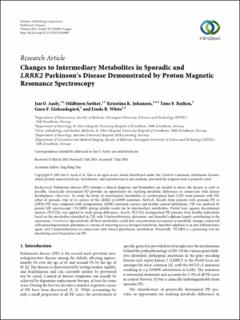| dc.contributor.author | Aasly, Jan | |
| dc.contributor.author | Sæther, Oddbjørn | |
| dc.contributor.author | Johansen, Krisztina Kunszt | |
| dc.contributor.author | Bathen, Tone Frost | |
| dc.contributor.author | Giskeødegård, Guro F. | |
| dc.contributor.author | White, Linda | |
| dc.date.accessioned | 2020-05-13T09:07:49Z | |
| dc.date.available | 2020-05-13T09:07:49Z | |
| dc.date.created | 2015-10-23T10:16:11Z | |
| dc.date.issued | 2015 | |
| dc.identifier.citation | Parkinson's Disease. 2015, 2015 . | en_US |
| dc.identifier.issn | 2090-8083 | |
| dc.identifier.uri | https://hdl.handle.net/11250/2654186 | |
| dc.description.abstract | Background. Parkinson’s disease (PD) remains a clinical diagnosis and biomarkers are needed to detect the disease as early as possible. Genetically determined PD provides an opportunity for studying metabolic differences in connection with disease development. Objectives. To study the levels of intermediary metabolites in cerebrospinal fluid (CSF) from patients with PD, either of sporadic type or in carriers of the LRRK2 p.G2019S mutation. Methods. Results from patients with sporadic PD or LRRK2-PD were compared with asymptomatic LRRK2 mutation carriers and healthy control individuals. CSF was analysed by proton MR spectroscopy (1H-MRS) giving reliable results for 16 intermediary metabolites. Partial least squares discriminant analysis (PLS-DA) was applied to study group differences. Results. PLS-DA distinguished PD patients from healthy individuals based on the metabolites identified in CSF, with 2-hydroxybutyrate, glutamine, and dimethyl sulphone largely contributing to the separations. Conclusion. Speculatively, all three metabolites could alter concentration in response to metabolic changes connected with neurodegeneration; glutamine as a means of removing excess nitrogen from brain, dimethyl sulphone as an anti-inflammatory agent, and 2-hydroxybutyrate in connection with altered glutathione metabolism. Potentially, 1H-MRS is a promising tool for identifying novel biomarkers for PD. | en_US |
| dc.language.iso | eng | en_US |
| dc.publisher | Hindawi | en_US |
| dc.rights | Navngivelse 4.0 Internasjonal | * |
| dc.rights.uri | http://creativecommons.org/licenses/by/4.0/deed.no | * |
| dc.title | Changes to intermediary metabolites in sporadic and LRRK2 Parkinson's disease demonstrated by proton magnetic resonance spectroscopy | en_US |
| dc.type | Peer reviewed | en_US |
| dc.type | Journal article | en_US |
| dc.description.version | publishedVersion | en_US |
| dc.source.pagenumber | 9 | en_US |
| dc.source.volume | 2015 | en_US |
| dc.source.journal | Parkinson's Disease | en_US |
| dc.identifier.doi | 10.1155/2015/264896 | |
| dc.identifier.cristin | 1283000 | |
| dc.description.localcode | Copyright © 2015 Jan O. Aasly et al. This is an open access article distributed under the Creative Commons Attribution License, which permits unrestricted use, distribution, and reproduction in any medium, provided the original work is properly cited. | en_US |
| cristin.ispublished | true | |
| cristin.fulltext | original | |
| cristin.qualitycode | 1 | |

